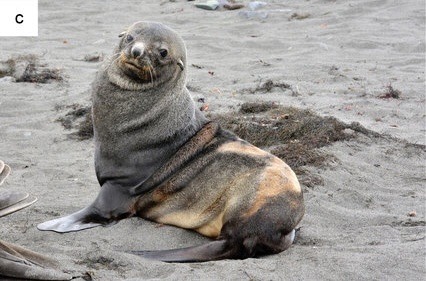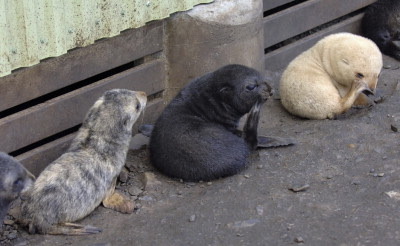Today's Seal Is: My Watchful Mama

Today's Seal Is: My Watchful Mama
More Posts from Fursealfan and Others


Aerial photos of J-pod socialising
Photos by SR3/SEA (source)
Begging you for some pinnipeds any pinnipeds please
Piebald Northern fur seal

Atypical colored Antarctic fur seal! With the orange, white, and grey they look calico.

Leucistic Antarctic fur seal

Interesting gang of Antarctic fur seal, one is leucistic and one almost looks brindle?

Leucistic southern elephant seal

Northern fur seal labeled as albino and partial albino (leucistic?) by some sources. NOAA says albino and they are experts.

Albino harbor seal

Albino ringed seal

Melanistic grey seal

Wildlife tourism isn’t always a more ethical choice.

I often see people who are under the assumption that wildlife tourism is free from ethical concerns, or that it’s inherently a more ethical choice than visiting a zoo/aquarium.
Wildlife tourism encompasses a wide variety of activities that involves watching wildlife in engage with their natural habitat. This includes safaris, whale watching, birding, photography tours, and a host of other activities. Wildlife tourism by itself can be an ethical way to see wildlife, however that is not always the case. There’s actively many harmful parts of wildlife tourism, that people may overlook since the animals are “free.”
So.. what would be some examples of unethical wildlife tourism?
- Whale petting in Baja Mexico. This activity actively contributes to the habituation of whales and disrupts their natural behaviors. Habituated whales are at a higher risk of encountering boat strikes - which can lead to physical injury or even death.
- Fake/bad acting sanctuaries. Sanctuaries are not always ethical, and many advertise activities such as elephant rides, elephant bathing, and advocate for people to touch/hold animals. The training methods they often utilize use fear or coercion, this is often actively stressful to the animals, and can be particularly dangerous to the tourists engaging with these animals.
- Swimming with whales. Studies show that commercial swim with whale tours can negatively impact the behaviors of some baleen whale species. These behaviors include avoidance and decreased rest time.
Spoiler: Injured wildlife

Is there ethical wildlife tourism?
Absolutely! Wildlife tourism should be done with respect for the animals. There should be careful steps taken to avoid habituation and harassment of wildlife.
Some of my favorite options include visiting a national park, bird watching, and doing careful research to find ethical whale watching companies. Additionally, many AZA accredited zoos offer animal interactions that are done in a safe & non-stressful manner for the animals. These may even include giraffe feedings and up close educational encounters.

"Eavesdropping on whale songs over the last six years is providing new information vital to answering questions about these giants of the ocean.
The number of whale songs detected is associated with shifting food sources, according to the California scientists—and the number of days humpbacks have been singing has nearly doubled.
When monitoring baleen whale songs in the Pacific Ocean, researchers found year-to-year variations correlated with changes in the availability of the species they forage on.
In vast oceans, monitoring populations of large marine animals can be a “major challenge” for ecologists, explained Dr. John Ryan, a biological oceanographer at the Monterey Bay Aquarium Research Institute in California (MBARI).
Their team deployed underwater microphones called hydrophones to study and track baleen whales, which communicate over long distances through sound.
“Surprisingly, the acoustic behavior of baleen whales provides insights about which species can better adapt to changing ocean conditions,” said Dr. Ryan, a lead author of the study.
They also monitored songs from blue, fin, and humpback whales off the West Coast of the U.S. to see what the song data could reveal about the health of their ecosystem.
The findings, published in the journal PLOS One, showed “large” year-to-year variations in whale song detection.
“The amount of humpback whale song continually increased, with their songs being detected on 34% of days at the beginning of the study and rising to 76% of days after six years,” said Dr. Ryan.
“These increases consistently tracked improved foraging conditions for humpback whales across all study years—large increases in krill abundance, followed by large increases in anchovy abundance.
“In contrast, blue and fin whale song rose primarily during the years of increasing krill abundance.
“This distinction of humpback whales is consistent with their ability to switch between dominant prey. An analysis of skin biopsy samples confirmed that changes had occurred in the whales’ diets.”
He explained that other factors, including the local abundance of whales, may have contributed to patterns in song detections observed in some years, but changes in foraging conditions were the most consistent factor.
“Overall, the study indicates that seasonal and annual changes in the amount of baleen whale song detected may mirror shifts in the local food web.”
WHALES ON THE COMEBACK TRAIL: • Gray Whale, Extinct for Centuries in Atlantic, Is Spotted in Cape Cod • Sighting of Many Blue Whales Around Seychelles is First in Decades – ‘Phenomenal’ • Majestic Sei Whales Reappear in Argentine Waters After Nearly a Century
“The results suggest that an understanding of the relationship between whale song detection and food availability may help researchers to interpret future hydrophone data, both for scientific research and whale management efforts”, which could better protect endangered species."
-via Good News Network, March 1, 2025


sealed with a kiss 💋
casey and hogan - seattle aquarium

Don’t make me put your ass in the sealbarrow

lets lean on a pipe with mama (x)
Today's Seals Are: Robot Uprising
please stop calling the california sea lions that are acting abnormally “demonic”. they are experiencing domoic acid toxicosis. domoic acid (DA) is a neurotoxin that is made by an algae called pseudo-nitzschia australis. fish eat the algae and the sea lions eat the fish. this buildup of DA in their system is what causes the behaviours we’re seeing. symptoms of DA toxicosis include: lethargy, disorientation, unpredictable behaviour, seizures, brain damage, and eventually death.
as far as we know, there have only been two unprovoked sea lion attacks on beaches. the vast majority of sea lions with DA toxicosis are not aggressive unless provoked. they are disoriented and they are acting out of fear.
DA is naturally occurring, but the algal blooms of pseudo-nitzschia australis have been increasing due to rising temperatures from climate change and water pollution. we are doing this to them.
affected sea lions seem to have pretty much a 50% chance of survival with treatment. they need IV fluids to flush out the toxin and some will need seizure medication as well. the marine mammal care center is completely overwhelmed with the amount of sick sea lions they are taking in and they need funding to keep up. you can donate to them here.
always stay at least 45 meters / 50 yards away from marine mammals! it protects both them and us!
-
 prettyawwkward liked this · 3 weeks ago
prettyawwkward liked this · 3 weeks ago -
 boytoydistraught reblogged this · 3 weeks ago
boytoydistraught reblogged this · 3 weeks ago -
 boytoydistraught liked this · 3 weeks ago
boytoydistraught liked this · 3 weeks ago -
 freshcarrotsfinally liked this · 3 weeks ago
freshcarrotsfinally liked this · 3 weeks ago -
 sanctimoniously-pious liked this · 3 weeks ago
sanctimoniously-pious liked this · 3 weeks ago -
 hemlockfortheheart liked this · 3 weeks ago
hemlockfortheheart liked this · 3 weeks ago -
 kingindecisive reblogged this · 3 weeks ago
kingindecisive reblogged this · 3 weeks ago -
 weasleywheezy liked this · 3 weeks ago
weasleywheezy liked this · 3 weeks ago -
 etcblahblah liked this · 3 weeks ago
etcblahblah liked this · 3 weeks ago -
 ambibug liked this · 3 weeks ago
ambibug liked this · 3 weeks ago -
 trashy-opossum liked this · 3 weeks ago
trashy-opossum liked this · 3 weeks ago -
 thegendermanenderman liked this · 3 weeks ago
thegendermanenderman liked this · 3 weeks ago -
 selkiegemm reblogged this · 3 weeks ago
selkiegemm reblogged this · 3 weeks ago -
 selkiegemm liked this · 3 weeks ago
selkiegemm liked this · 3 weeks ago -
 stardewaddicted liked this · 3 weeks ago
stardewaddicted liked this · 3 weeks ago -
 bayshandy reblogged this · 3 weeks ago
bayshandy reblogged this · 3 weeks ago -
 thehoardhorde liked this · 3 weeks ago
thehoardhorde liked this · 3 weeks ago -
 enderjo12 liked this · 3 weeks ago
enderjo12 liked this · 3 weeks ago -
 gaylittleeldritchhorror liked this · 3 weeks ago
gaylittleeldritchhorror liked this · 3 weeks ago -
 ailathemoodentity liked this · 3 weeks ago
ailathemoodentity liked this · 3 weeks ago -
 vipra reblogged this · 3 weeks ago
vipra reblogged this · 3 weeks ago -
 floor-based reblogged this · 3 weeks ago
floor-based reblogged this · 3 weeks ago -
 fablecreatesstuff liked this · 3 weeks ago
fablecreatesstuff liked this · 3 weeks ago -
 unclassyfied404 liked this · 3 weeks ago
unclassyfied404 liked this · 3 weeks ago -
 yehoria liked this · 3 weeks ago
yehoria liked this · 3 weeks ago -
 ririwithrice reblogged this · 3 weeks ago
ririwithrice reblogged this · 3 weeks ago -
 bluesciencefoodoperator reblogged this · 3 weeks ago
bluesciencefoodoperator reblogged this · 3 weeks ago -
 bluesciencefoodoperator liked this · 3 weeks ago
bluesciencefoodoperator liked this · 3 weeks ago -
 chadmojito reblogged this · 3 weeks ago
chadmojito reblogged this · 3 weeks ago -
 forevertrill55 liked this · 3 weeks ago
forevertrill55 liked this · 3 weeks ago -
 voidark reblogged this · 3 weeks ago
voidark reblogged this · 3 weeks ago -
 voidark liked this · 3 weeks ago
voidark liked this · 3 weeks ago -
 kholden83 reblogged this · 3 weeks ago
kholden83 reblogged this · 3 weeks ago -
 kayymarieeee liked this · 3 weeks ago
kayymarieeee liked this · 3 weeks ago -
 archer-archer-archer liked this · 3 weeks ago
archer-archer-archer liked this · 3 weeks ago -
 shortkidenergy liked this · 3 weeks ago
shortkidenergy liked this · 3 weeks ago -
 stop-entropy-lie-down liked this · 3 weeks ago
stop-entropy-lie-down liked this · 3 weeks ago -
 izzepop liked this · 3 weeks ago
izzepop liked this · 3 weeks ago -
 pileof3pancakes liked this · 3 weeks ago
pileof3pancakes liked this · 3 weeks ago -
 comixqueen liked this · 3 weeks ago
comixqueen liked this · 3 weeks ago -
 morguemouth reblogged this · 3 weeks ago
morguemouth reblogged this · 3 weeks ago -
 gothamizhome liked this · 3 weeks ago
gothamizhome liked this · 3 weeks ago -
 catfolx liked this · 3 weeks ago
catfolx liked this · 3 weeks ago -
 sakuracards reblogged this · 3 weeks ago
sakuracards reblogged this · 3 weeks ago -
 g4yr4t reblogged this · 3 weeks ago
g4yr4t reblogged this · 3 weeks ago -
 yusalka liked this · 3 weeks ago
yusalka liked this · 3 weeks ago -
 wishmaid reblogged this · 3 weeks ago
wishmaid reblogged this · 3 weeks ago

